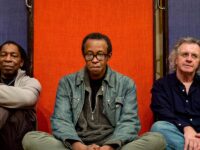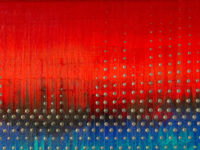The idea of combining jazz and South Indian folk music isn’t a new one; we’ve inspected some very interesting such hybrids come from everyone from percussion whiz Sameer Gupta to ex-Journey drummer Steve Smith. Of course, John McLaughlin did this too in the mid 70s with his Shakti project. And Rudresh Mahanthappa’s Kinsmen (2008) album might be the definitive foray down that path.
Nonetheless, the idea remains new enough that there is plenty of unexplored territory in this field, and violinist Arun Ramamurthy is on an expedition with his first Arun Ramamurthy Trio album, Jazz Carnatica (out October 28, 2014). This one gives Mahanthappa’s minor masterpiece a good run for its money.
Ramamurthy didn’t stumble upon the right formula for mixing Western and Subcontinental forms of music, he’s prepared for this undertaking practically his entire life. Raised in New Jersey to South Indian parents, Ramamurthy grew up soaking up the American music of his surroundings and the Carnatic music of his heritage, even getting private instruction from a Carnatic guru. But that wasn’t enough to quench his thirst to understand this music, so he lived in India for a year to learn directly from the true, renowned masters. When he returned, he found kindred spirits among jazz musicians, and he formed his trio with jazz cats who also hav a background in Indian music: Perry Wortman (bass) and Gupta on drums.
Most of the songs selected for Jazz Carnatica were written by Indian classical composers, and some of these songs are centuries old. Ramamurthy renders all of these as ragas, an Indian tonal scheme for both composition and improvisation. Improvisation is often the bridge for Ramamurthy to link Carnatic music and jazz. On songs like “Dhanasri” and the original composition “Delusions,” melody and rhythm are inseparable, blurring the lines between scored and improvised as Ramamurthy and Gupta traverse through rapid harmonic intonations together.
Beyond the alluring structure of the music, Ramamurthy’s violin more than anything makes the connection between India and America clear. He often mimics an Indian singer’s inflections and overall delivery, evident on “Dhanasri” and on nearly every other song. But on other tracks, such as “Daha G,” he plays fiddle right alongside that south Indian style. He wrings a sorrowful delivery from his violin on “Darbari Kanada” and on the following elegant ballad “Govardhana” you can hear hints of European classical characteristics in his playing.
The trio is augmented by the leader of another Gupta-drummed trio, pianist Marc Cary. His spacey synth accentuates the dark, two-chord melody of “4th Dimension,” which also boasts a great, dancing groove thanks to Wortman’s well-placed bass. Cary drops a rousing piano solo in the middle of that. The mood turns brighter for “Simple Joys,” a highly syncopated piano/drums/bass figure and another pleasing piano solo from Cary that’s limber like the melody.
For all the exotica oozing from this kind of jazz, there’s never the feeling that this is some offbeat experiment. The reason for this can be traced to Arun Ramamurthy himself. Carnatic jazz is practically his life’s calling and he answers that call to virtual perfection with Jazz Carnatica.
Visit Arun Ramamurthy’s website for more info.
- Ches Smith Quartet – ‘Clone Row’ (2025) - May 30, 2025
- James Brandon Lewis Quartet – ‘Abstraction Is Deliverance’ (2025) - May 27, 2025
- Soft Machine – ‘Drop’ (1971, 2025 remaster) - May 21, 2025



